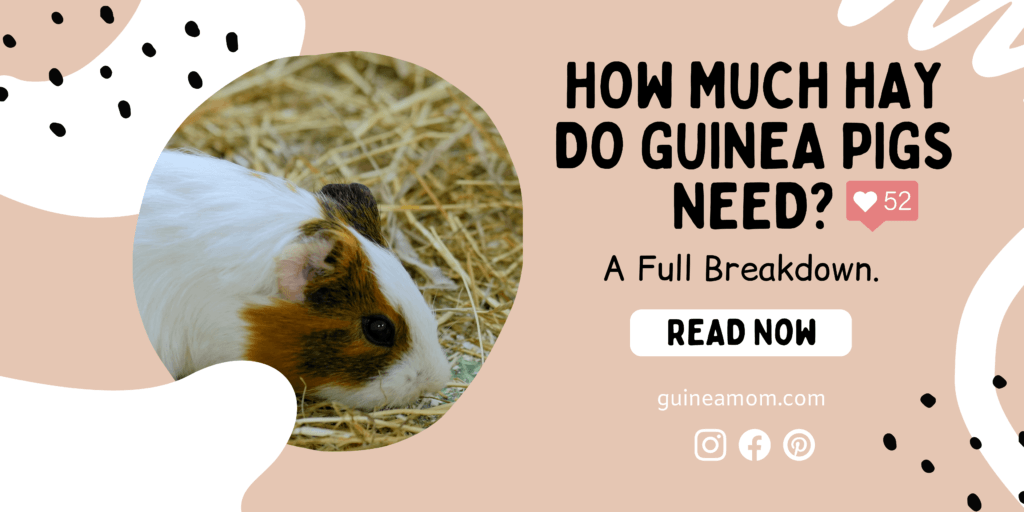Unlike many other animals, guinea pigs cannot manufacture their own vitamin C. It is a vital nutrient for health, so guinea pigs must ingest adequate levels in their diets. That´s why it´s important to know guinea pigs foods that are high in vitamin C.
Guinea pigs require 10-20 mg of vitamin C every day to maintain good health. Pregnant or nursing guinea pigs need more than that (30-40 mg) and unhealthy guinea pigs may need up to 100 mg of vitamin C a day!
You don´t need to worry about overdosing your guinea pigs with vitamin C because any excess vitamin C is excreted through the urine and not absorbed by the body.
Table of Contents
The Importance of Vitamin C for Guinea Pigs
Severe vitamin C deficiency can lead to a condition known as scurvy. Symptoms of scurvy in guinea pigs include joint swelling and pain, difficulty and unwilligness to move, weight loss, lethargy and extreme weakness, diarrhea, dental problems, rough fur, bruising – to name but a few!
This severe condition can be fatal if left untreated. Therefore it´s important to prevent it by providing your guinea pig foods that are high in vitamin C. So, here´s a list of the best vitamin C-rich vegetables! There are few issues to consider though.
It´s all about balance!
Providing fresh fruits and vegetables to your guinea pig is a good way to satisfy their need for vitamin C. However, keep in mind the following rules:
Give your guinea pig sparingly veggies that have high level of SUGAR or CALCIUM in them.
High sugar foods can make your guinea pig overweight or cause intestinal issues. High calcium foods instead can predispose to bladder stones.
Therefore, it´s all about balance when it comes to guinea pigs diet! That´s why the following list shows in addition to C vitamin levels also the sugar and calcium values of each veggie and fruit.
Best Vegetables for Guinea Pigs That Are High in Vitamin C
Feeding your guinea pig vegetables and fruits is one of the best ways to satisfy your guinea pig´s need for vitamin C. However, some vegetables and fruits can only be fed more sparingly than others. Let´s find out how you should build your guinea pig´s diet!
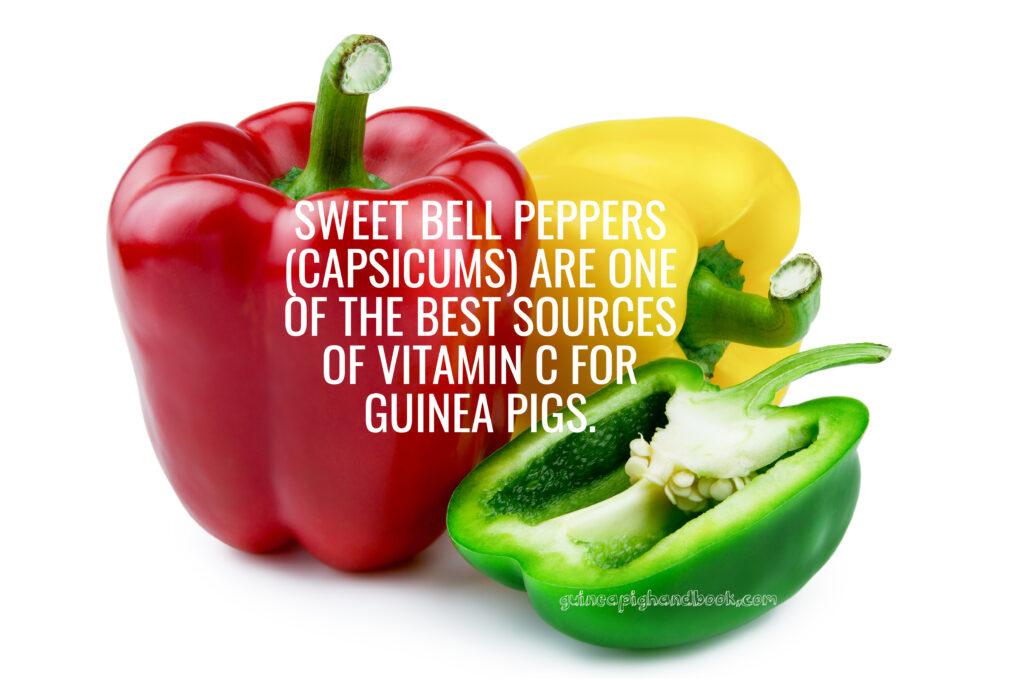
Sweet Bell Peppers
Sweet bell peppers (capsicums) are one of the best sources of vitamin C for guinea pigs. You can buy them in many colors and they all taste a bit different – by buying different colors, you can easily bring variety to your guinea pig’s diet!
Red bell peppers have the highest level of vitamin C (300mg per cup) but also the highest level of sugar (9 grams per cup) in them.
Orange and yellow bell peppers are both vitamin C rich with some sugar in them.
Green bell peppers contains less vitamin C (160mg per cup) than its sweeter sisters red, orange and yellow, but with lower sugar content (6 grams per cup) it is a great veggie for guinea pigs.
You can feed bell peppers to your guinea pig daily, but remember to vary between different colours! Bell peppers have more sugar than leafy greens but less than fruits. However, with low calcium levels they are great vegetables to feed to your guinea pig.
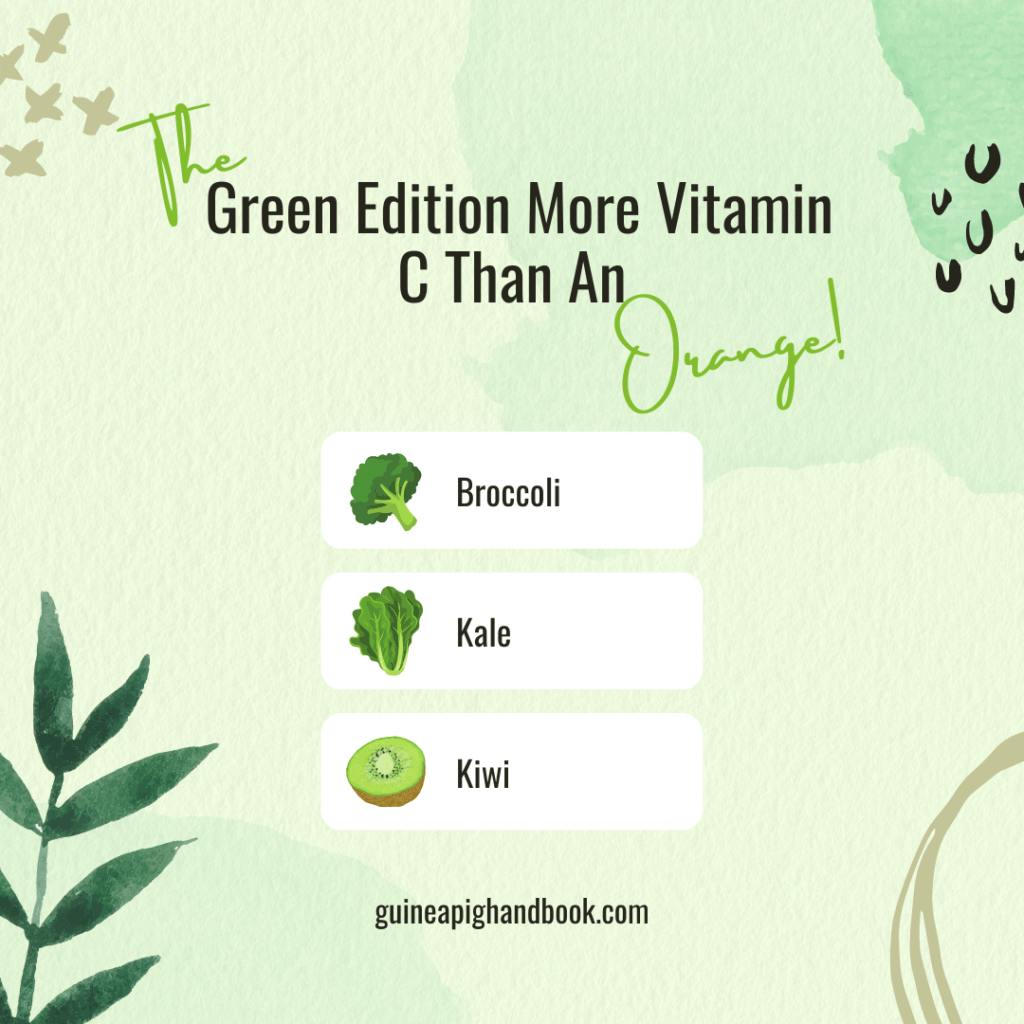
Parsley
Parsley is packed with vitamin C (260mg per cup) and it´s very low in calories, which makes it a great food for guinea pigs. It is also packed with great flavour – no wonder why guinea pigs love parsley so much!
However, due to its high calcium levels (276mg per cup) you should only give it to your quinea pig sparingly.
Kale
Kale is considered a superfood due to its high level of vitamins and minerals.
It´s packed with vitamin C (200mg per cup) but also with calcium (400mg per cup). Therefore, you should add kale to your guinea pigs diet sparingly and mix it up with vegetables with less calcium.
Guava
This exotic fruit will definitely bring variety to guinea pigs´ diet! A single guava fruit has double the amount of vitamin C as compared to an orange!
Due to its high sugar, acidity and phosphorus levels, you shouldn´t give it to your guinea pig more than once or twice a week.
Orange
Oranges are widely recognized as one of the top sources of vitamin C (106mg per cup). However, oranges have high levels of sugar (24grams per cup) and calcium (100mg per cup) so you should feed them sparingly to your guinea pig – a slice once or twice a week is enough.
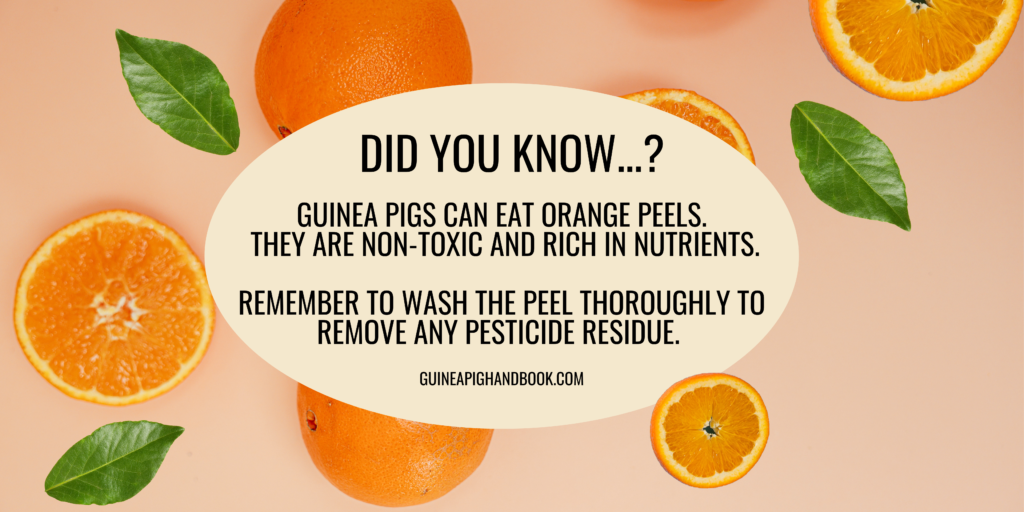
Thyme
Herbs, such as thyme, make a great addition to any guinea pigs´ food palette. You probably didn´t know that thyme is rich in vitamin C (1.3mg per 1tsp (0.8g)) and vitamin A, fiber, magnesium and potassium.
No wonder, its´ range of use is huge! Throughout centuries thyme has been used in rituals and also treating all kinds of conditions and medical problems.
Thyme is low in sugar but high in calcium. Therefore, you can give it to your guinea pig in small quantities once or twice a week.
Giving thyme to your guinea pig weekly will benefit their immune system, and give them important nutrients.
Mustard Greens & Turnip Greens
Mustard greens and turnip greens are similar when it comes to their nutritional value – both are great sources of vitamin C (mustard greens 160mg per cup, turnip greens 120mg per cup). Both have extremely high calcium levels (mustard greens 200mg per cup, turnip greens 380mg per cup).
Feed mustard and turnip greens in moderation once or twice a week. Mix these up with other healthy vegetables that have lower levels of calcium.
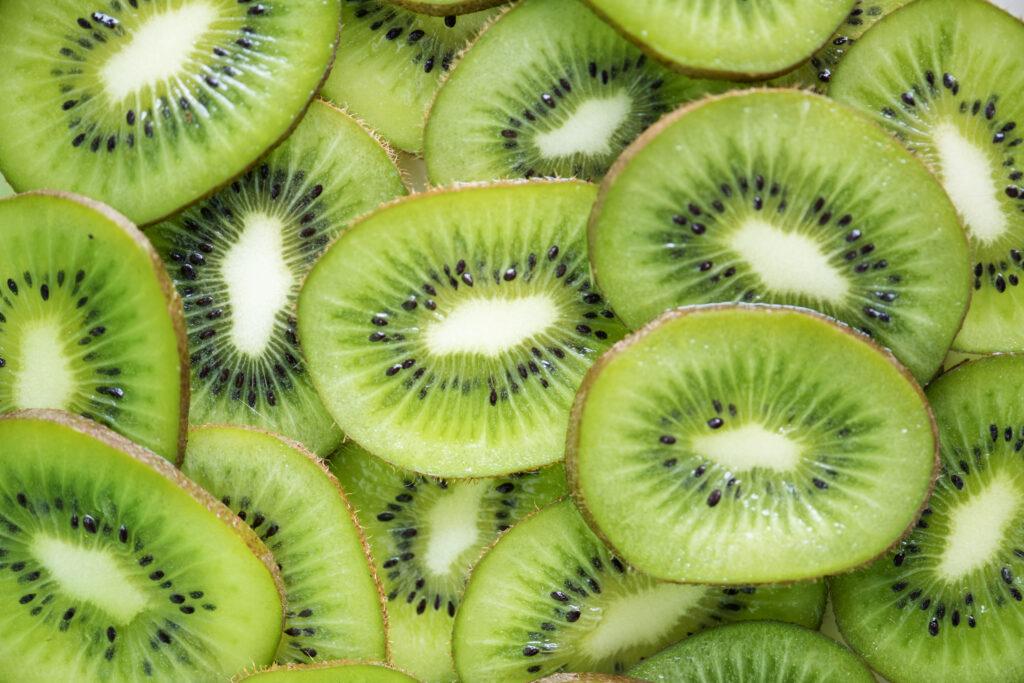
Kiwi
Kiwi is an excellent source of vitamin C (134.5 mg per cup). On top of that kiwis are a great way to add potassium, vitamin E & K, and folate to the diet.
Kiwi is extremely high in sugar (16grams per cup) so you should feed it sparingly. Guinea pigs can safely eat a small amount of kiwi once a week. Kiwi cannot be the main dish but a special treat!
Kiwis contain relatively high amouts of calcium (63mg per cup) and phosphorus, so to avoid any stomach issues and bladder stones, stick to the nutritional recommendation.
Mango
This fruit is not only delicious but also boasts an impressive nutritional content including vitamins, minerals and antioxidants.
Mango is a great source of vItamin C (60.1 mg per cup) but, unfortunately, it is relatively high in natural sugar compared with other fresh fruits (22grams per cup). Therefore it´s best to serve it only once or twice a week as a special goody. A one-inch cube is a perfect serving size for an adult guinea pig.
Remember to give only the flesh to your pet and remove any seeds, skin and pits as they can cause a choking hazard. Cut the flesh into bite-sized pieces.
Strawberries
As we all know, strawberries are YUMMY! They’re an excellent source of vitamin C (112mg per cup) and most guinea pigs just LOVE them (with the top and all!)!
Strawberries have less sugar (12grams per cup) than most fruits but to play safe, feed only one or two strawberries to your guinea pig per week.
Zucchini
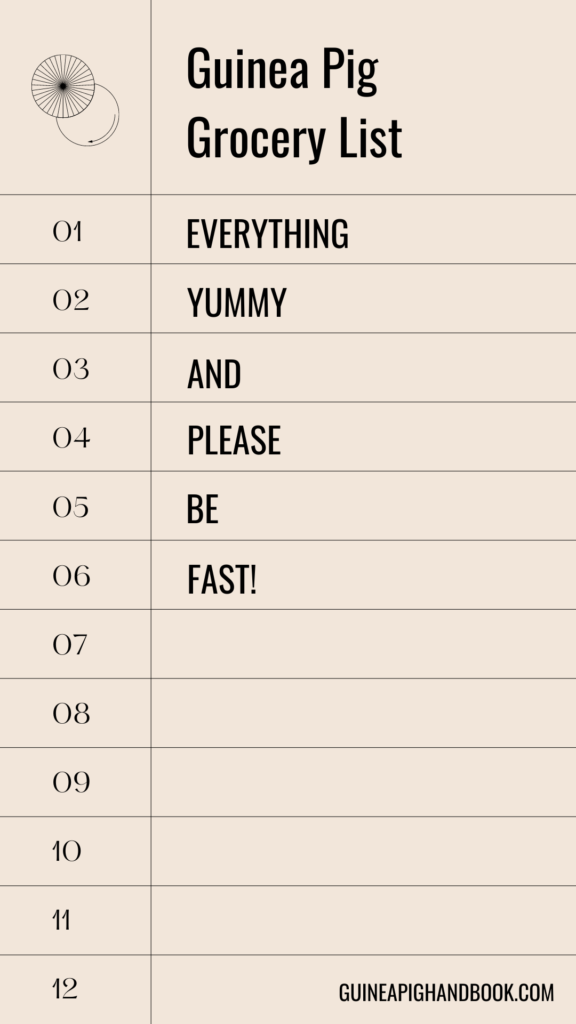
Is zucchini safe for guinea pigs? Yes, it is, and most guinea pigs find it mouthwatering! It has a good amount of vitamin C in it (40mg per cup), and also other nutrients and minerals essential to the health of a guinea pig.
Zucchini has low sugar index, so, you don’t have to worry about your cavie gaining weight. However, due to the calcium level of zucchini (39,6mg per cup) it´s best to restrict the treat to about a 1 inch chunk at a time once or twice per week.
Cantaloupe
Cantaloupe is sweet and delicious fruit and, quite surprisingly, it has the lowest sugar index of the melons. Cantaloupe is a good source of vitamin C (17,4mg per cup).
Still you should give it to your cavie as a rare treat due to its´ high phosphorus levels. One or two one-inch cubes of the fruit maximum once a week will make a tasty and refreshing snack for your guinea pig.
Remember to remove the rind and the seeds before feeding it to your cavies as they can cause choking risk.
Tomatoes
Tomatoes are nutritional powerhouses including vitamins A, B, D, and K and also potassium, zinc, and iron. Tomatoes have also decent amount of vitamin C (24,7mg per cup) and calcium (18mg per cup).
Guinea pigs either LOVE tomatoes or run away when you try to serve them these luscious and juicy snacks. If your cavie loves them, you can give a slice of a larger tomato or one cherry tomato a few times a week.
Remember to remove any leaves of stems before feeding this treat to your cavie as they are poisonous. Also make sure the tomatoes are ripe before giving it to your pet.
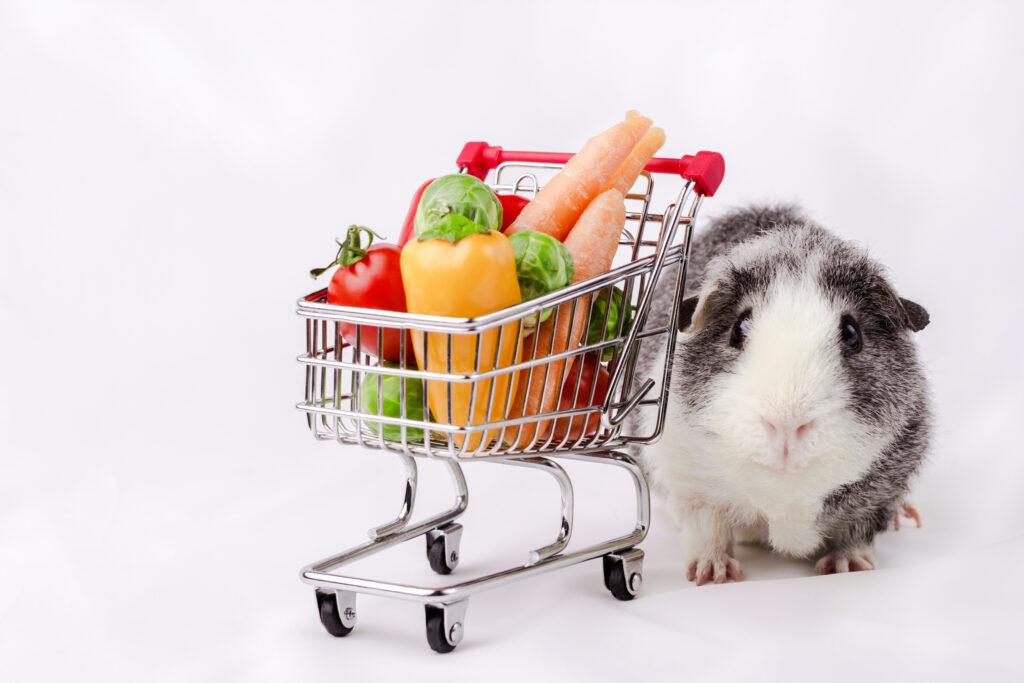
Broccoli & Cauliflower
Broccoli is high in many nutrients, including fiber, vitamin K, iron and potassium. Its vitamin C level is high (186mg per cup) but so is its calcium level (94mg per cup).
Cauliflower is naturally high in B vitamins, antioxidants, phytonutrients, fiber and also vitamin C (52mg per cup).
It´s important to introduce broccoli and cauliflower slowly into your guinea pig´s diet as they are gassy vegetables. To avoid stomach issues, discomfort and bladder stones caused by excess calcium you should feed these vegetables only couple times a week just a few bites at a time.
The flower part (“curd”) of these vegetables has the highest amount of vitamin C, but also the stalks are vitamin C rich.
To Sum Up!
Giving C vitamin-rich vegetables and fruits to your guinea pig is an easy way to satisfy their need for vitamin C. As we all know, vegetables and fruits are healthy, and an important part of a healthy diet. In addition to vitamin C, they provide a great deal of other important vitamins, such as vitamin K and vitamin A, minerals and other essential nutrients. Remember to wash all fruits and vegetables before giving them to your guinea pigs to remove pesticide residues.
By mixing up different vegetables and fruits you make sure you don´t feed your guinea pig too much calcium or sugar. High calcium foods can predispose to bladder stones. High sugar foods, instead, can make your guinea pig overweight or cause intestinal issues. By mixing up different types of foods will also ensure that your guinea pigs have some variety in their diet (you also don´t want to eat the same foods every day, do you?).
Remember that it´s crucial to be slow and gradual when it comes to feeding your guinea pig anything new. This is for two reasons:
1. New foods can cause stomach upsets and digestion problems.
2. Your guinea pig might be allergic to some veggies or fruits. Therefore, it´s important to observe your guinea pigs after feeding them anything new. Contact vet immediately if you see any signs of an allergic reaction or abnormal behaviour.
Try new foods one at a time and don´t be discouraged if your guinea pig doesn´t like it immediately.
I hope you find this article helpful and eye-opening! It would be awesome to hear from you! If you have any questions or comments whatsoever, please let me know in the comments below. I will be more than happy to help you out!

